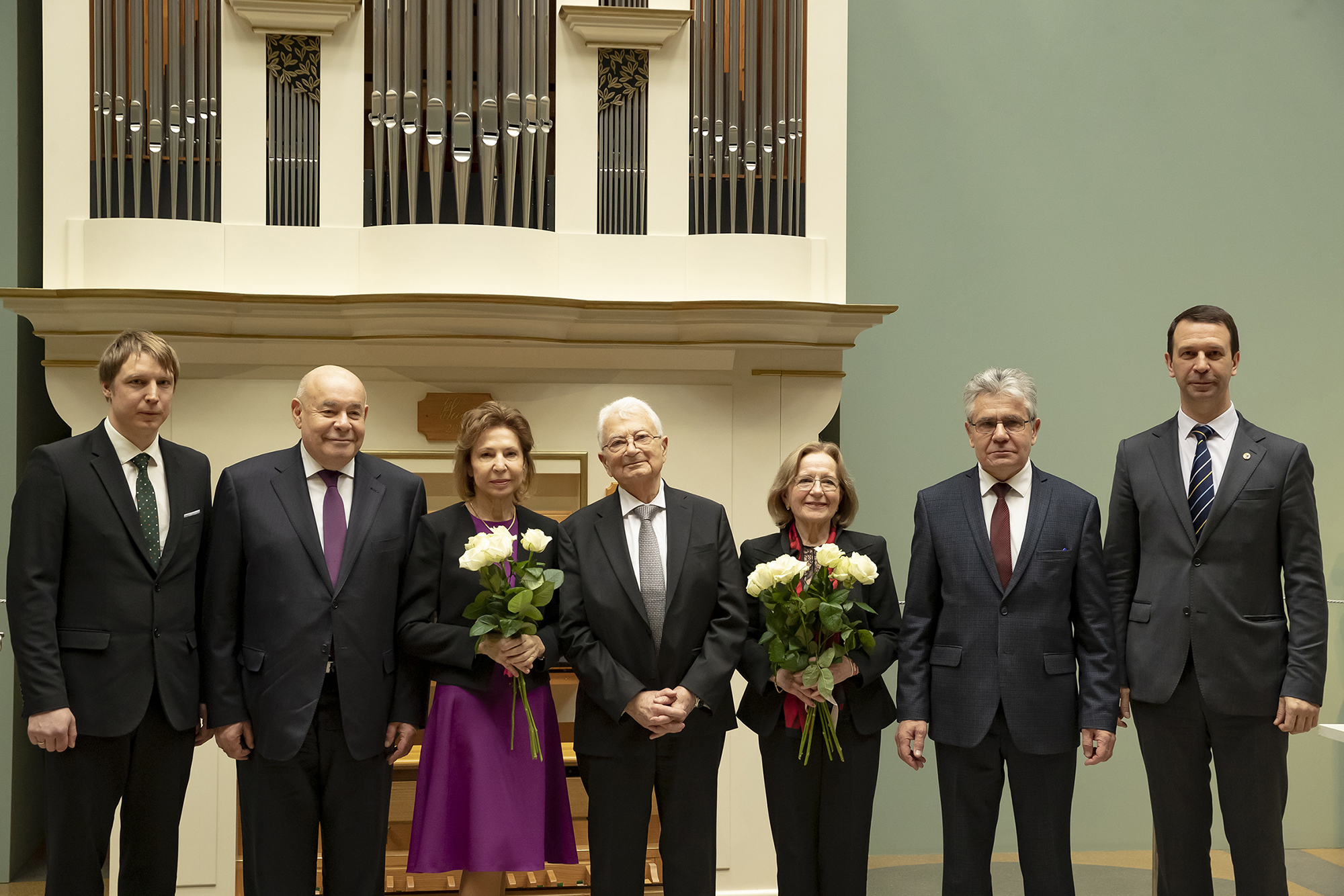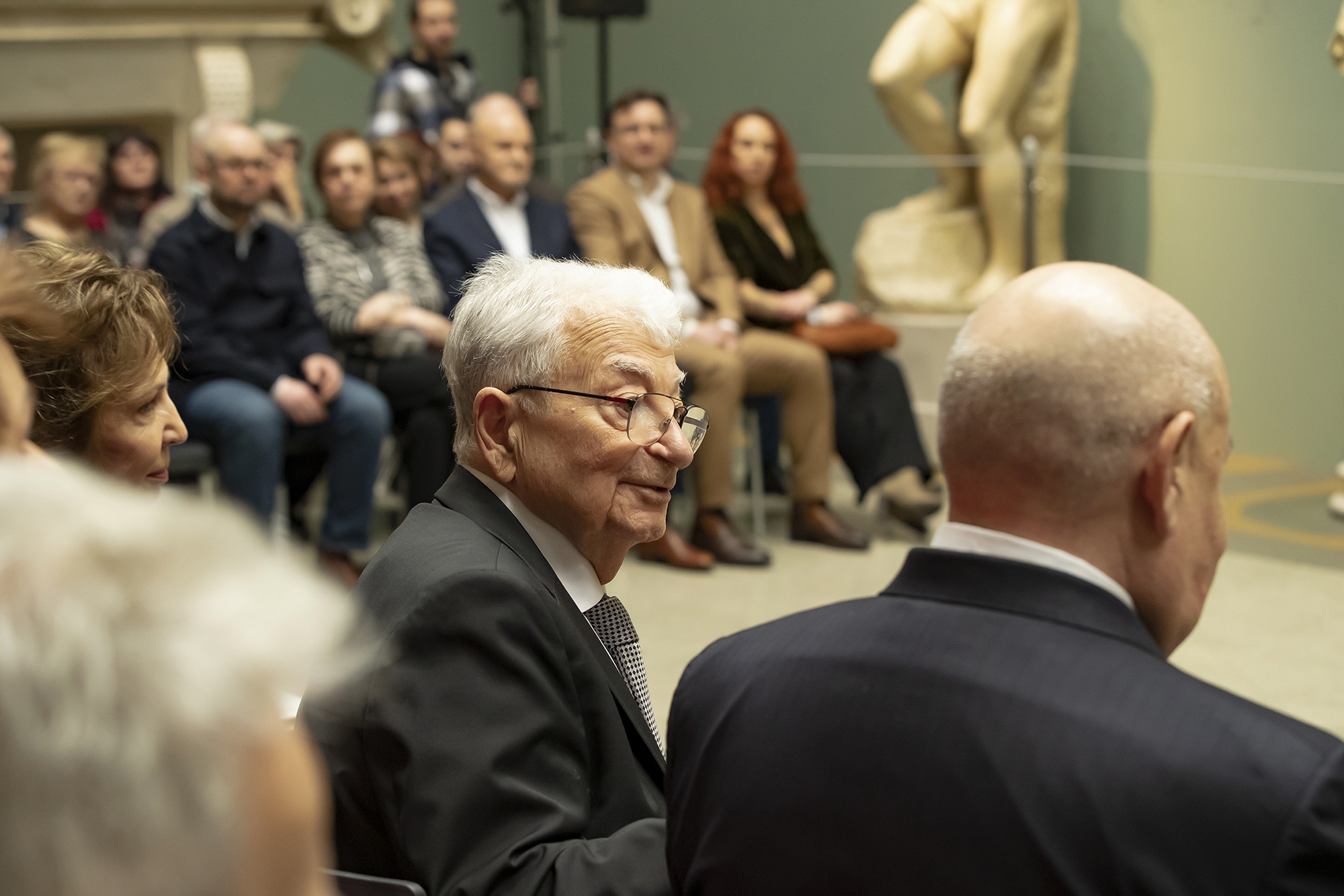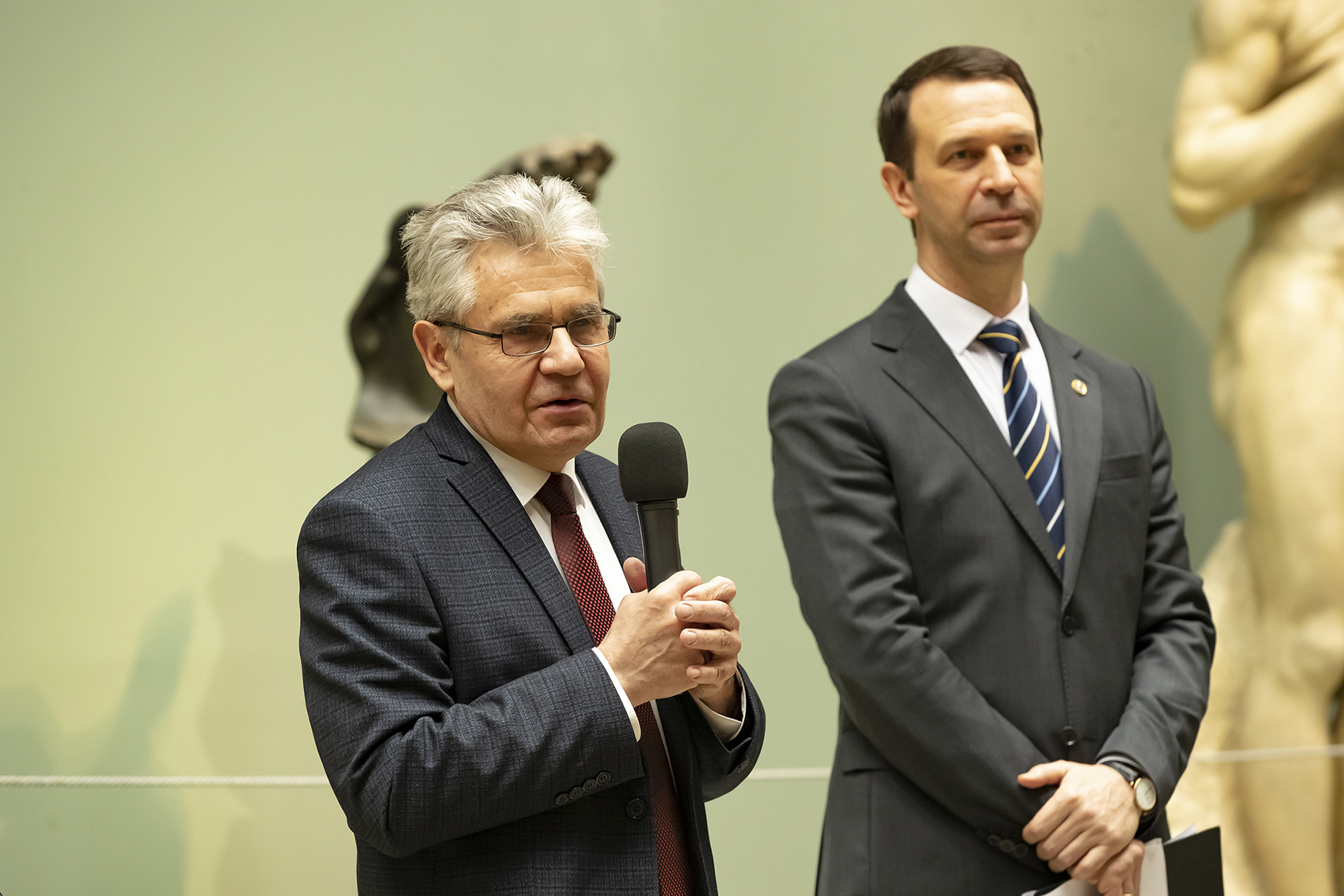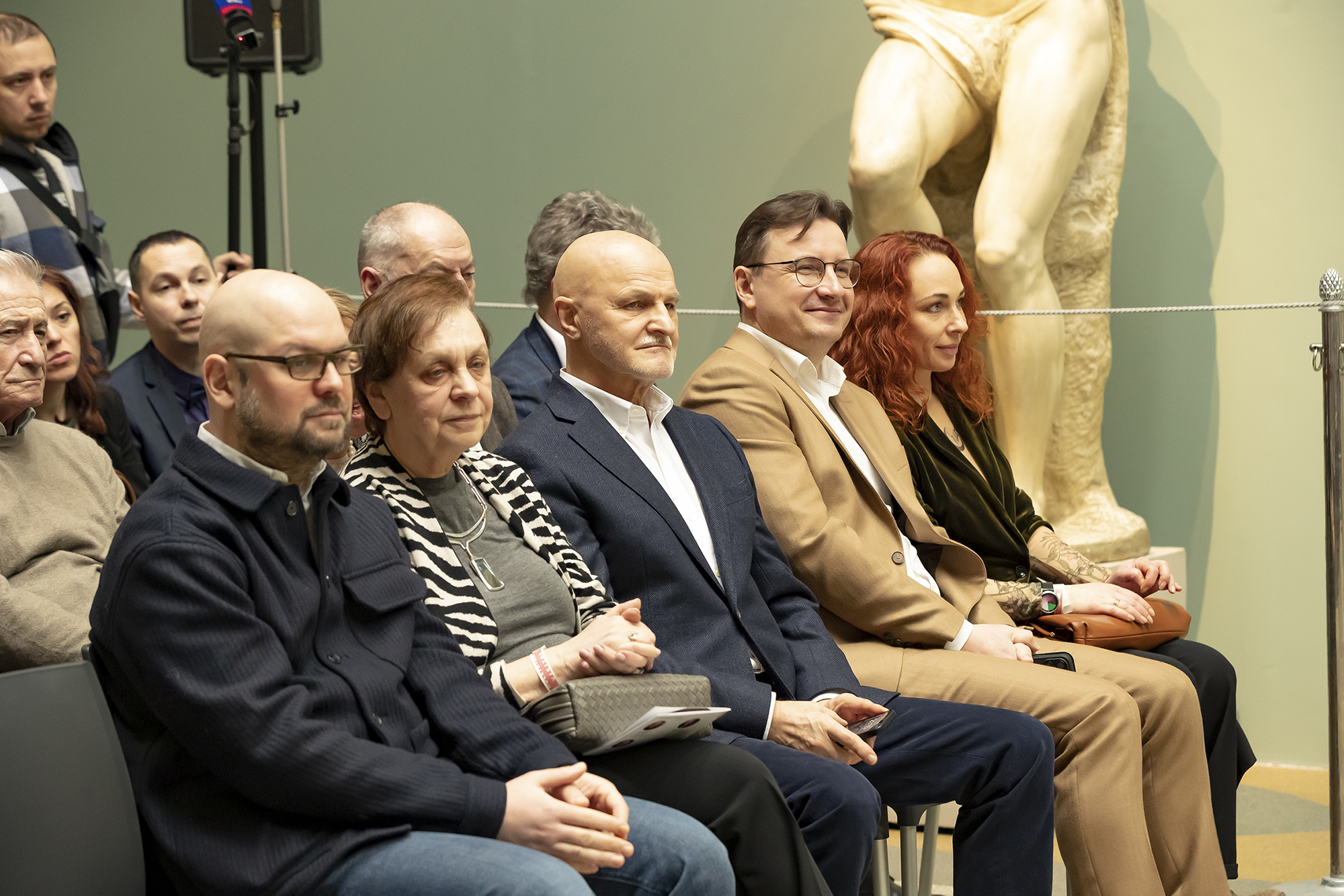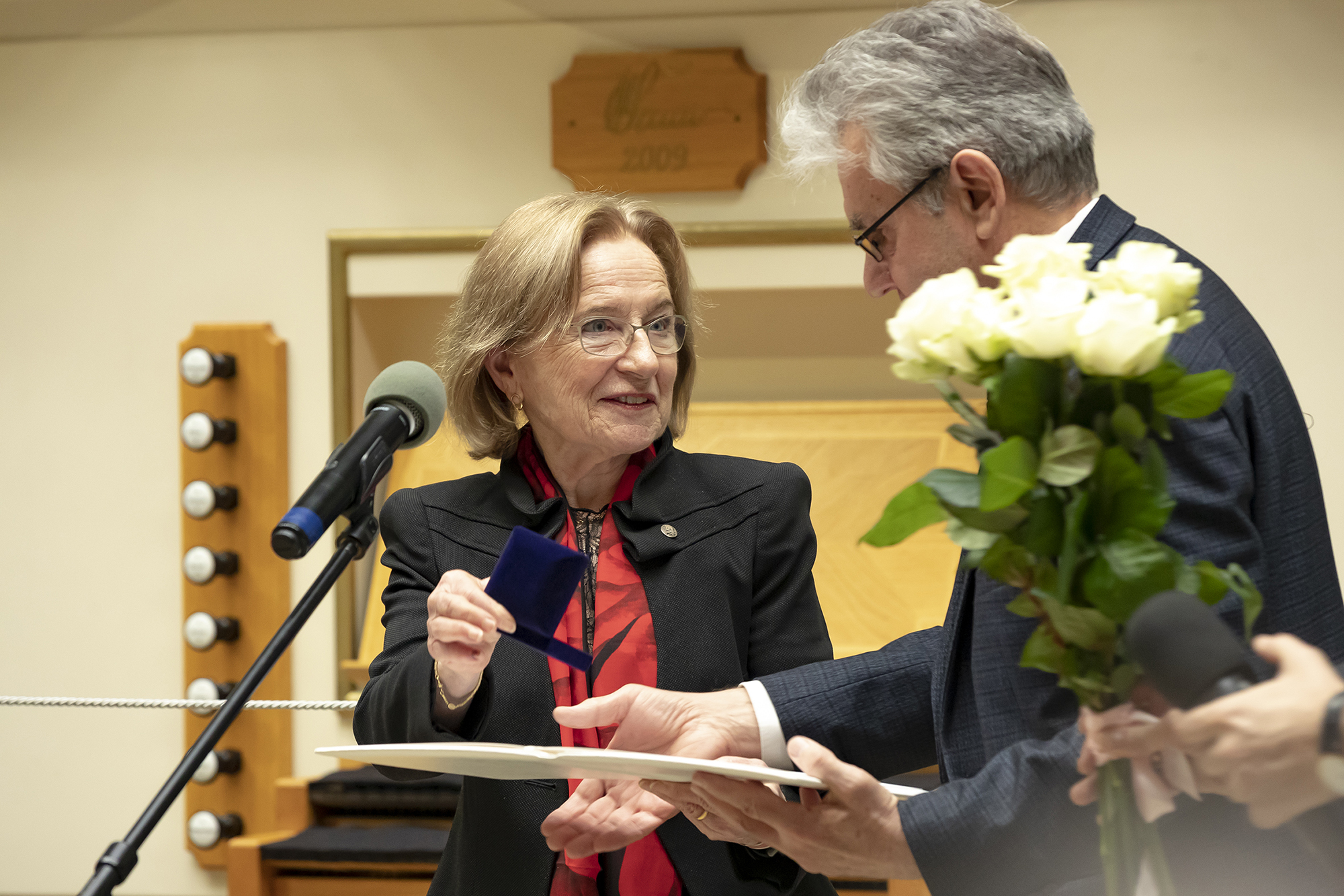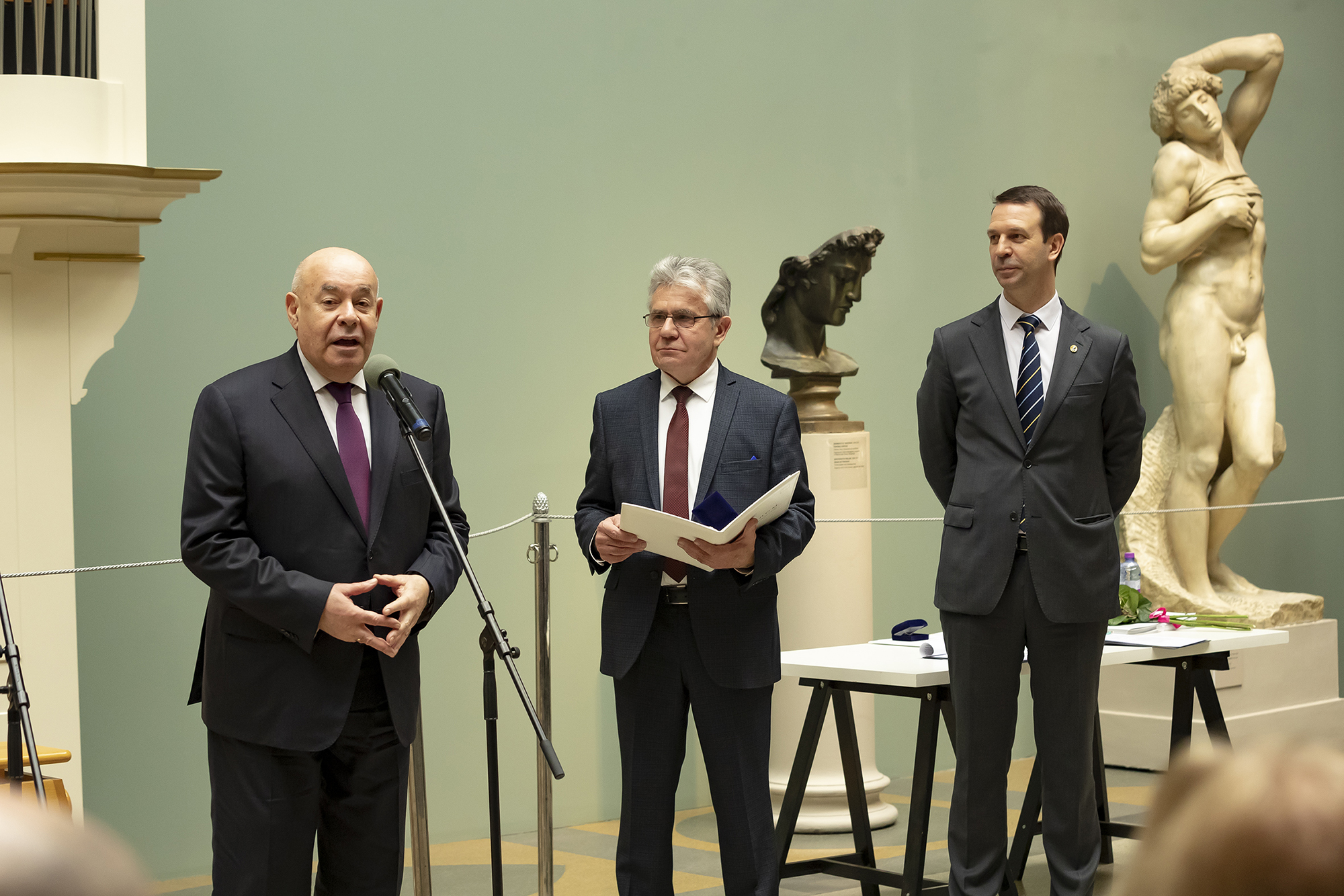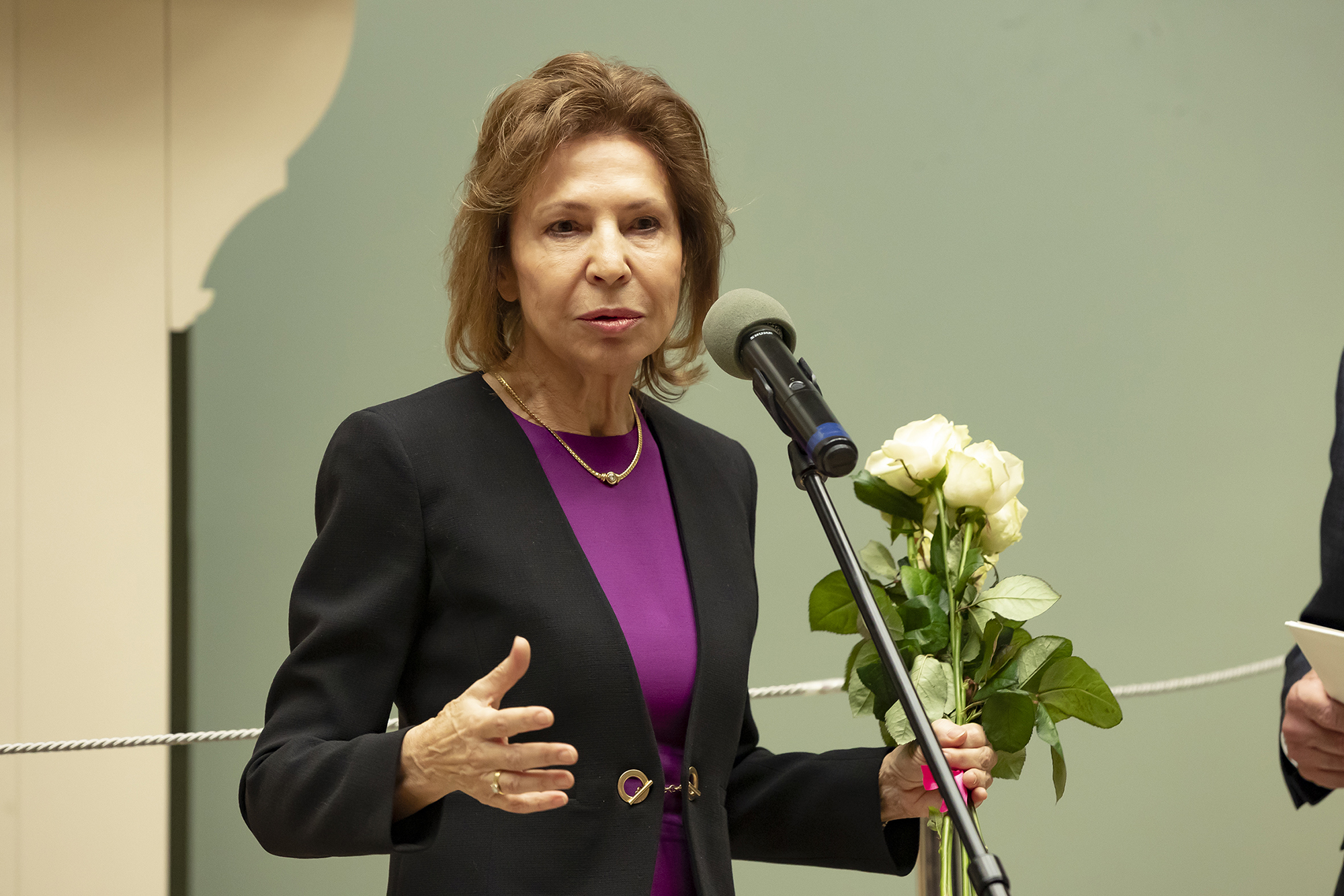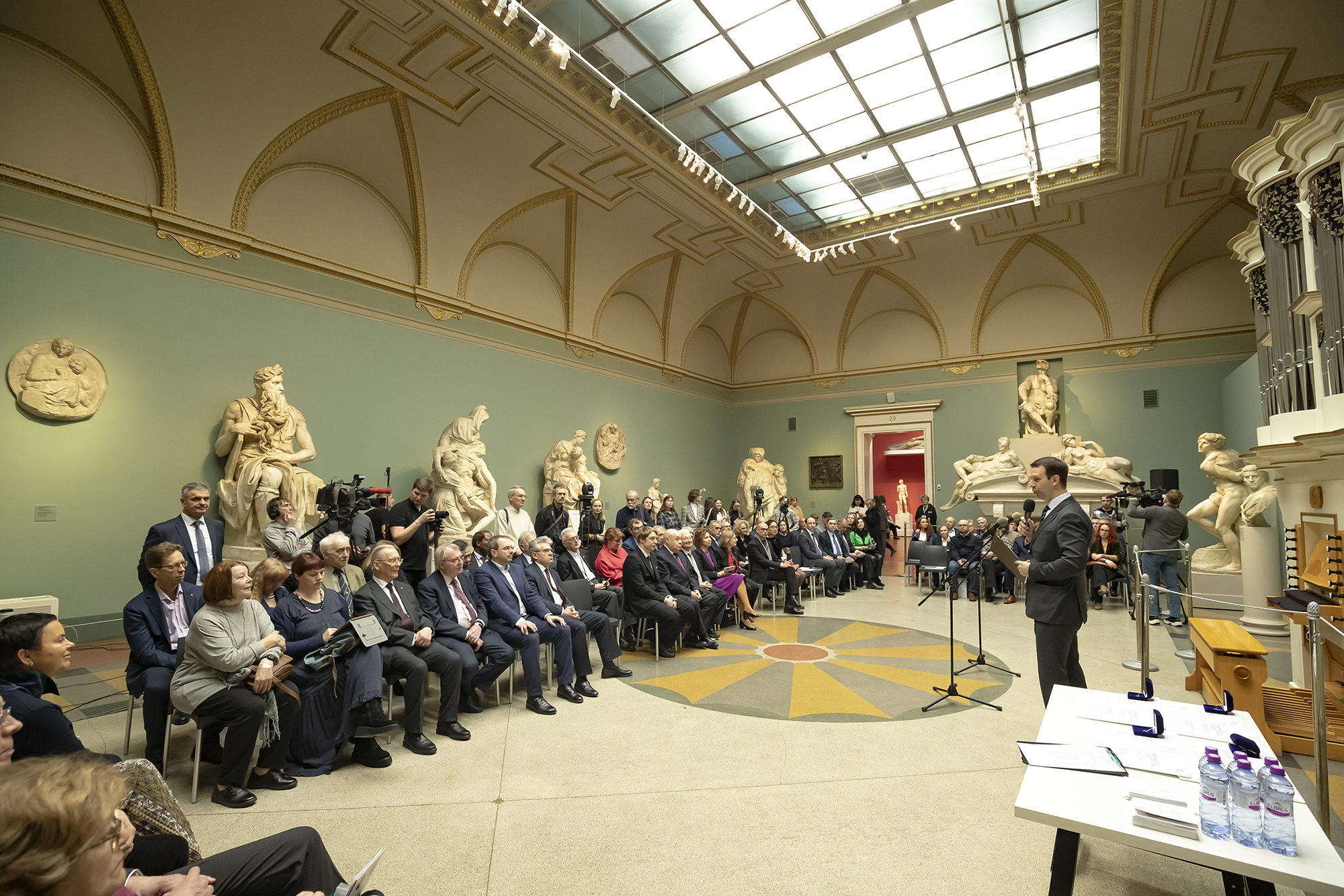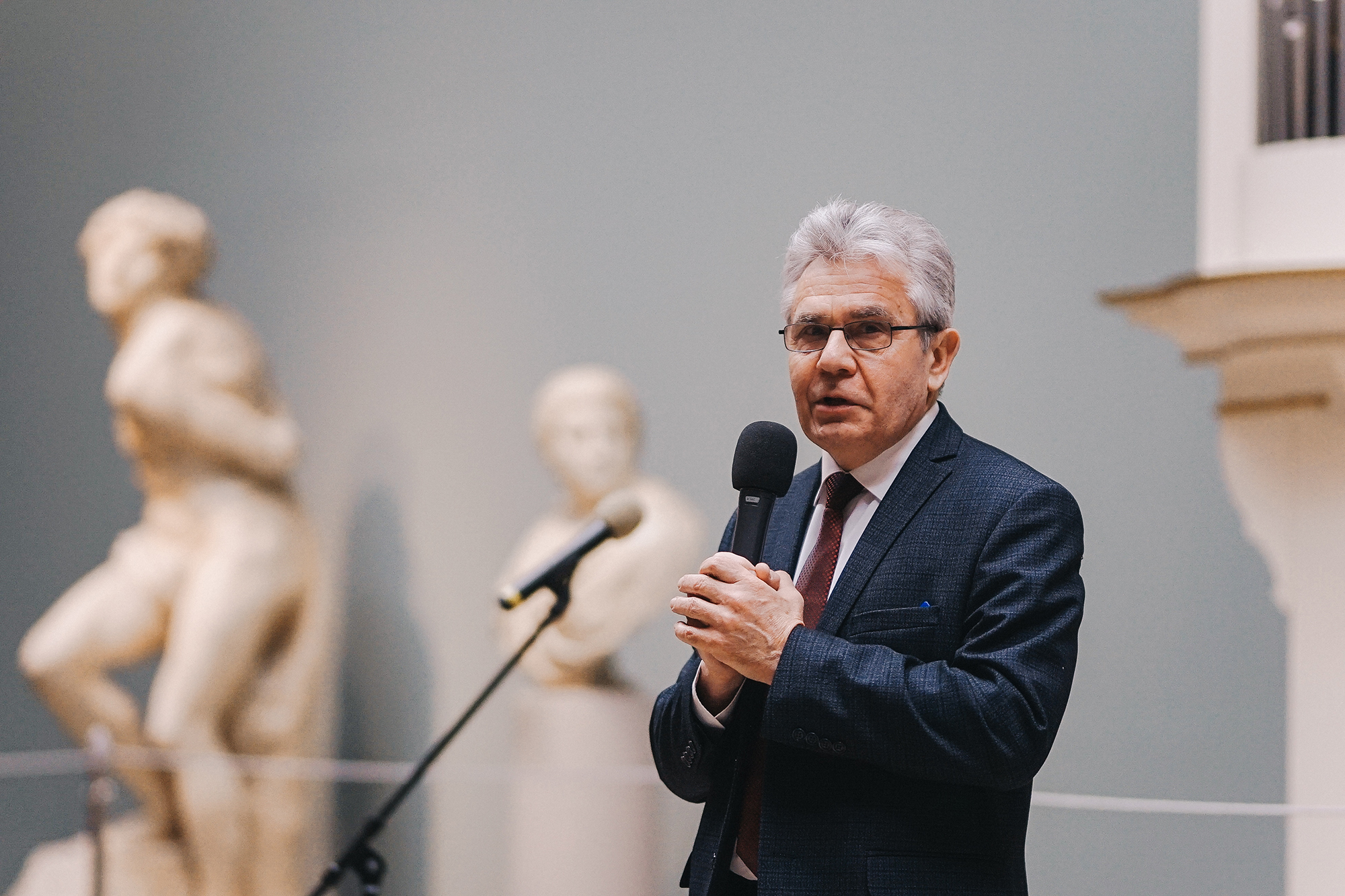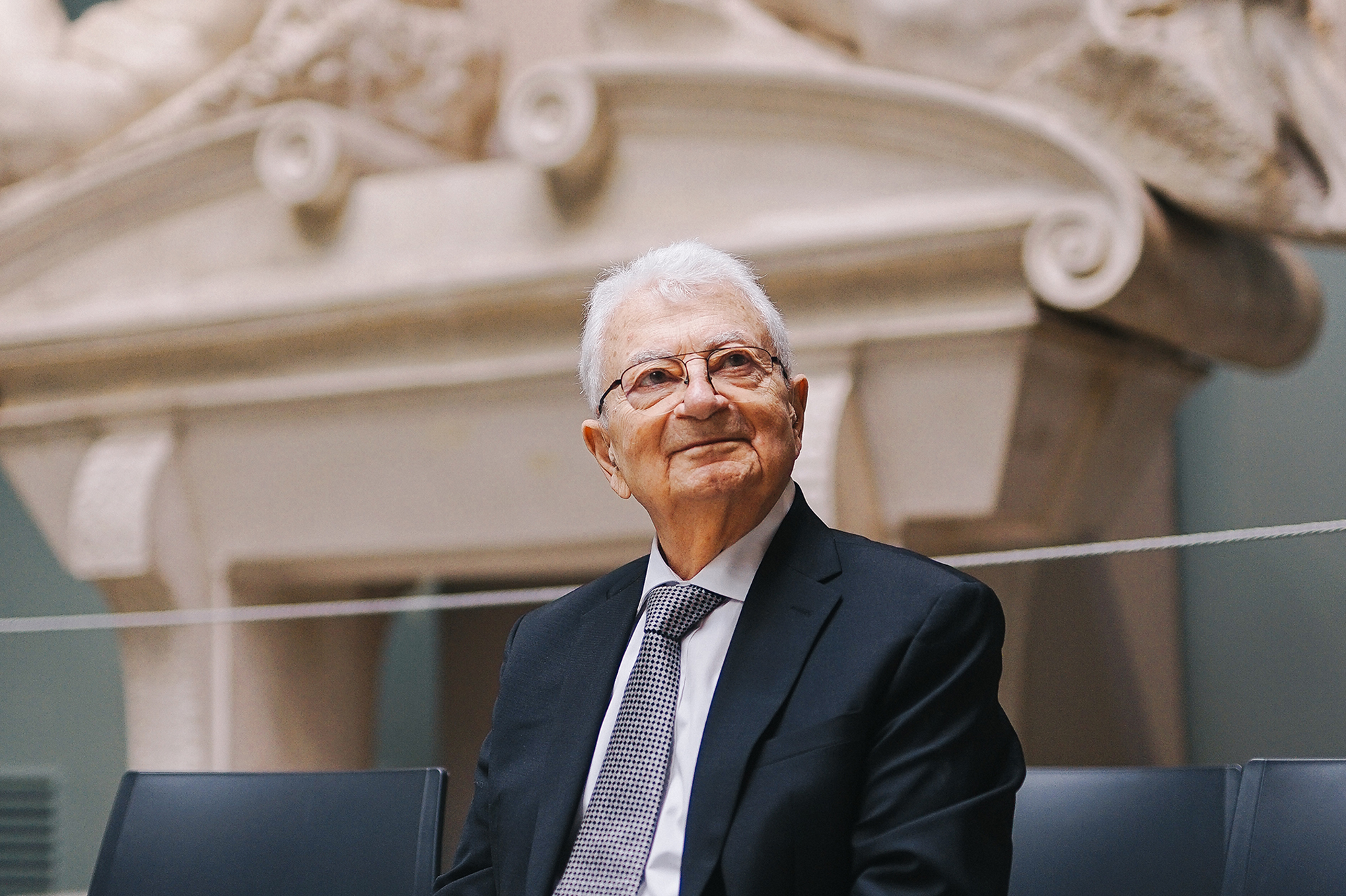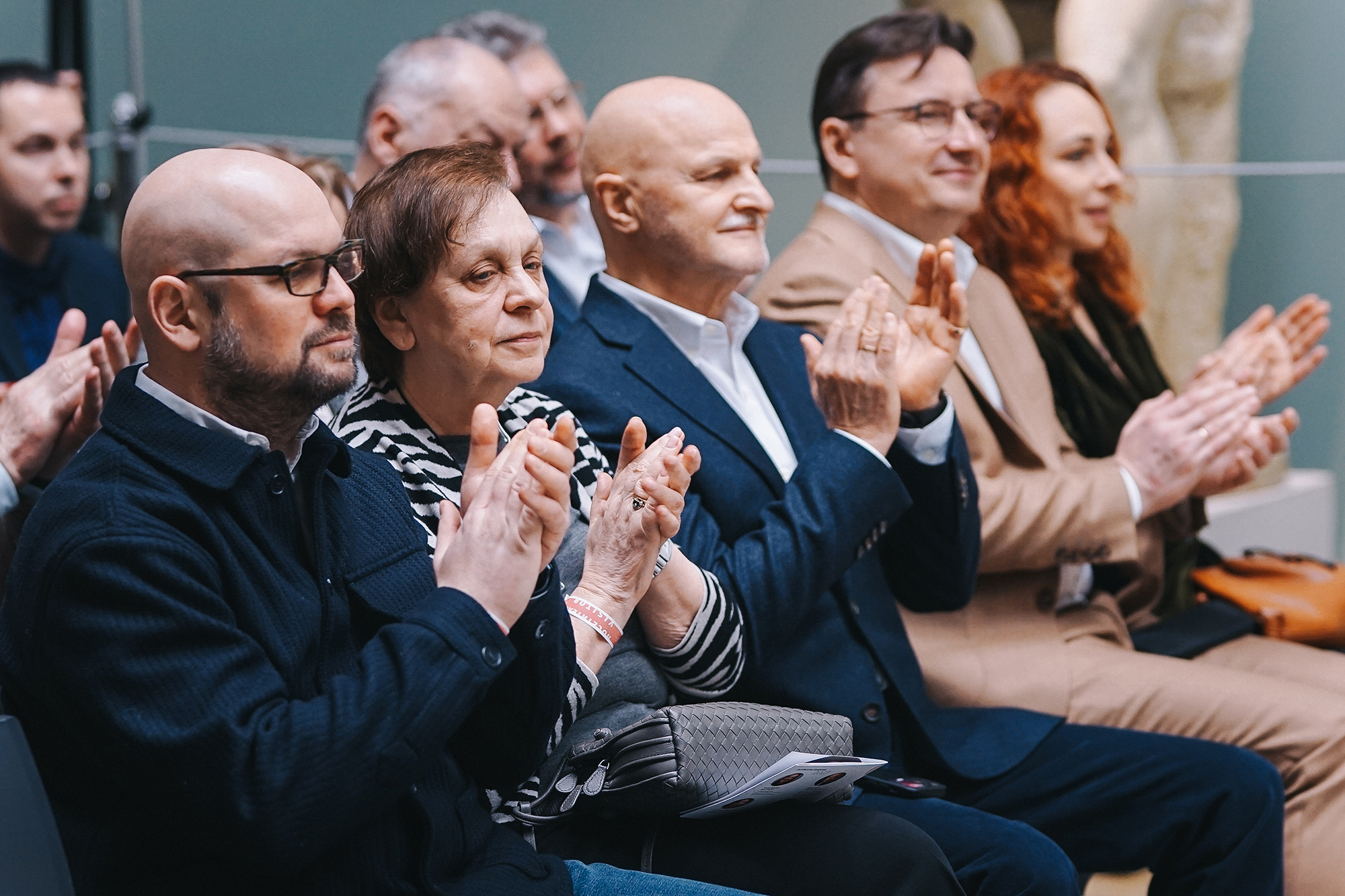First winners of OGANESSON Prize awarded
News, 17 February 2024
On the evening of 16 February, the first award ceremony of the OGANESSON Prize took place. Pushkin State Museum of Fine Arts in Moscow hosted the grand event. The award was established in 2023 by RAS Academician Yuri T. Oganessian and the Joint Institute for Nuclear Research to support researchers and popularisers of science.
In 2022, Yuri Oganessian received the first Sber Scientific Prize for his fundamental work on the synthesis of superheavy elements and contribution to the establishment of the accelerator experimental base that open the prospect for revolutionary nuclear technologies. He decided to direct the 20 million roubles that he received to create a new scientific award at JINR. The funds served as the basis for establishing the OGANESSON Prize for scientists and educators.
Representatives of scientific organizations and Russian ministries, cultural and art figures, and media workers gathered in the Michelangelo Hall of one of the world’s leading museums to participate in the grand event.
JINR Director, RAS Academician Grigory Trubnikov opened the ceremony. He expressed gratitude to the administration of the Pushkin Museum, the Ministry of Culture, the Ministry of Science and Higher Education, and the Ministry of Foreign Affairs of the Russian Federation for supporting the prize and assisting in organizing the event.
“The diverse audience of today’s ceremony proves once again that science truly can bring nations together. Over the past two days, a session of the international JINR Scientific Council took place in Dubna. Among attendees were the representatives of many countries: South Africa, Bulgaria, Armenia, Belarus, Brazil, Mexico, Cuba, Mongolia, Uzbekistan, Romania, and Kazakhstan. Many members of the Council are present today not only as guests, but also as participants of the event. This is truly wonderful,” JINR Director Grigory Trubnikov noted.
Chairperson of the jury of the OGANESSON Prize, Scientific Leader of the Russian National Centre for Physics and Mathematics, former President of the Russian Academy of Sciences Alexander Sergeev gave a speech. He quoted the words of Academician of the Academy of Sciences of the Soviet Union Andrey Sakharov about the importance of scientific and technological progress through “the preservation of the humane in human and the natural in nature.”
“The times are turbulent and difficult, and that inevitably impacts our lives and the way we see the present and the future. It is very important that all the laureates we honour today are the people who focus on the future in the face of present adversities. We should all understand our responsibility for the world’s advancement,” Alexander Sergeev emphasised in his speech to the attendees.
The Michelangelo Hall of the Pushkin Museum applauded the first winner of the OGANESSON Prize, Ana María Cetto Kramis. Ana María, a physics professor at the National Autonomous University of Mexico, became the first woman in Mexico to get a doctorate. She received the prize for her outstanding scientific work in quantum mechanics and theoretical physics and great personal contribution to the strengthening of global scientific cooperation for peace and sustainable development.
Ana María Cetto Kramis started her speech by expressing gratitude to her husband who conducted scientific work in Moscow and introduced her to the achievements of Russian science. It was thanks to him that she learned about the Joint Institute for Nuclear Research in Dubna and many outstanding Russian researchers.
“During many, many years I’ve been promoting the internationalisation of science. For me, being able to be here as a member of the Scientific Council of the Joint Institute is important. We have to make real efforts to establish and keep the international links. Cooperation is very important, and not just because we can share our results in science, there is an additional importance: it’s about learning to know each other, to understand each other, because otherwise, there is no peace. And for me, the only science that values is science for peace,” Ana María Cetto Kramis said, emphasising the importance of cooperation.
Mikhail E. Shvydkoy, Doctor of Arts, Art Director of the Moscow Musical Theatre, received the prize for his outstanding personal contribution to the development of international scientific and cultural cooperation and the popularisation of modern science achievements in mass media.
The prominent figure of culture and education thanked the jury members for nominating him in a field outside of his specialisation. He also expressed gratitude to the Culture TV channel for the opportunity to cover the agenda of modern science and his family members for their support.
“Communication with scientists is communication with with free people. They want to know the world as it really is,” he said.
At the end of his speech, Mikhail Shvydkoy proposed an unexpected initiative. He suggested to direct the money either to scientific institutions to aid young researchers in their studies, or, alternatively, to establish a competition for schoolchildren from the regions of Russia. For example, for the best essays about the city of Dubna, children will be able to go on an excursion to the science city and visit the Joint Institute for Nuclear Research.
The third laureate of the OGANESSON Prize was Valeria Pershina, a chemistry professor at the GSI Helmholtz Centre for Heavy Ion Research in Darmstadt. She was awarded for theoretical studies of the electronic structure and chemical properties of superheavy elements of the Mendeleev’s Periodic Table.
The professor spoke about the “passing of the baton” in the discovery of superheavy elements from Germany to Russia. She gave special acknowledgement to the Superheavy Elements Factory at the Laboratory of Nuclear Reactions at JINR.
“Yuri Tsolakovich motivates us. He practically brought physical theory back to Russia and has always been advocating for all Russian-speaking scientists to concentrate their research on superheavy elements in Dubna as a unified scientific centre. It is now apparent that this is the place where a large amount of elements will be synthesised. And this means that it will soon be possible to study their chemical properties,” Valeria Pershina said.
In the nomination for young laureates, Head of the Scientific and Experimental Department of the Accelerator Complex of the Laboratory of Nuclear Reactions at JINR Vasily Semin became the winner. He received the prize for his significant personal contribution at the beginning of his scientific career to the creation of new JINR basic experimental facilities that provide breakthrough scientific results in nuclear physics. Vasily Semin led the commissioning of the DC-280 Cyclotron at the SHE Factory. Thanks to the successful operation of the accelerators, the accelerator complex achieved a world record level of beam intensity.
“This award is really significant for the entire community – it’s like a guiding light that appeared in difficult times. It reminds our society just how much we need international relations and cooperation in science and in the world. And the name of Yuri Tsolakovich and events like the establishment of a new prize always emphasise the interest in science in society,” Vasily Semin said.
During his ten years at JINR, he worked his way up from an engineer to the department head. “Our entire team deserves credit for the new scientific breakthroughs achieved through the once ambitious idea of the Superheavy Element Factory. I am grateful to my colleagues, mentors, and predecessors. The real scientific results we are yielding today are the fruits of their labour,” Vasily Semin said. He noted that three generations of his family have lived in Dubna: “My family has been closely tied to the Institute since 1957.”
In the final part of the ceremony, the founder of the award, Yuri T. Oganessian, gave a speech. “I don’t know what to say. I might just quote Chekhov. Lord, it’s so good!” he noted, sharing his emotions. Academician Oganessian thanked his colleagues from JINR for their help and support in organizing the award and expressed gratitude to the Chairperson of the Committee, Academician of the Russian Academy of Sciences Alexander Sergeev, Scientific Leader of the National Centre for Physics and Mathematics in Sarov, for the professional approach to nominating the laureates. “Choosing the best of the best is always a very difficult task, especially when you’re doing it for the first time. Today’s laureates are interconnected in many ways, although anyone who has done something outstanding in the field of science can claim the prize,” Yuri Oganessian emphasised.
Yuri Oganessian highlighted he was glad that the prize is awarded not only for scientific achievements, but also for the popularisation of science. He spoke about the popular science book by Ana María Cetto Kramis “Light: in Nature and in the Laboratory”, which has sold 100,000 copies. “It is extremely important for every researcher that what they do is popularised. The perception of their work by society holds great significance, since they are part of the society, too. And that’s what makes the popularisers irreplaceable,” he explained.
Speaking about the laureate Mikhail Shvydkoy, Yuri Oganessian stressed his merits in covering JINR’s work on the Culture TV channel. For the other two laureates, the award ceremony was especially symbolic. Valeria Pershina conducts theoretical research in the field of chemistry of superheavy elements and offers her own scientific justification that the 118th element Oganesson is a noble gas, while Vasily Semin, as part of the FLNR scientific team, will be able to confirm or refute this in practice.
The award ceremony ended with a commemorative group photo of the laureates and founders of the award. In his final speech, Alexander Sergeev expressed gratitude to Dubna: “Dubna is an outpost of global science. The Superheavy Element Factory and the NICA Collider are outstanding world-class projects. Today, Dubna is a true centre of international cooperation. The OGANESSON Prize creates a new tradition that will surely resonate with the scientific community not only in Russia, but in the entire world.”
